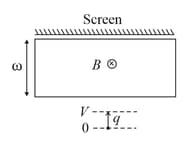An electron and a proton enter a magnetic field perpendicularly both have same kinetic energy. Which of the following is true?
Important Questions on Moving Charges and Magnetism
| Column 1 | Column 2 | Column 3 |
| 1. Electron with | (i) | (P) |
| 2. Electron with | (ii) | (Q) |
| 3.Proton with | (iii) | (R) |
| 4. Proton with | (iv) | (S) |
In which case would the particle move in a straight line along the negative direction of y axis
| Column 1 | Column 2 | Column 3 |
| 1. Electron with | (i) | (P) |
| 2. Electron with | (ii) | (Q) |
| 3.Proton with | (iii) | (R) |
| 4. Proton with | (iv) | (S) |
In which case will the particle describe a helical path with axis along positive z direction?
| Column 1 | Column 2 | Column 3 |
| 1. Electron with | (i) | (P) |
| 2. Electron with | (ii) | (Q) |
| 3.Proton with | (iii) | (R) |
| 4. Proton with | (iv) | (S) |
Two parallel metal plates and separated by a distance are connected to an ammeter. Photons of energy are incident on the photosensitive plate of threshold wavelength . The minimum value of the magnetic field to be applied parallel to the plates so that the current through the ammeter becomes zero is . Then the value of
is (mass of electron , charge of electron )
A rectangular region of dimensions has a constant magnetic field into the plane of the paper as shown. On one side the region is bounded by a screen. On the other side positive ions of mass and charge are accelerated from rest and towards the screen by a parallel plate capacitor at constant potential difference , and come out through a small hole in the upper plate. Which one of the following statements is correct regarding the charge on the ions that hit the screen?


